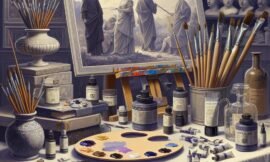Transitioning from acrylic painting to oil painting can be both exciting and challenging for artists who are ready to explore new mediums. While both have their unique characteristics, understanding the differences in materials, techniques, and cleaning processes can make the transition smoother. This guide aims to help intermediate painters smoothly transition from acrylics to oils, providing insight for both traditional art collectors and digital art enthusiasts.
Understanding the Differences Between Acrylic and Oil Paints
Drying Time
One of the most noticeable differences between acrylics and oils is the drying time. Acrylics dry very quickly, often within minutes, allowing artists to layer and complete works swiftly. Oils, on the other hand, take much longer to dry, ranging from a few days to weeks, which allows for more extended manipulation of the paint on the canvas. This can be both an advantage and a challenge for those transitioning.
Color and Texture
Acrylic paints tend to have a flat, matte finish once dried, whereas oil paints are known for their rich colors and glossy finish. Oils can show more depth and texture due to their thicker consistency, allowing for techniques like impasto, where paint is applied in thick layers to create texture on the canvas. Understanding and appreciating these differences can help artists harness the unique strengths of each medium.

Materials Needed for Oil Painting
Oil Paints
Invest in high-quality oil paints as they offer better pigmentation and consistency. Brands like Winsor & Newton, Gamblin, and Old Holland are popular among professional artists. Unlike acrylics, oils come in various grades, from student to professional quality, so choose according to your skill level and budget.
Mediums and Solvents
Unlike acrylics, which require only water for thinning and cleaning, oils need specific mediums and solvents. Linseed oil, turpentine, and mineral spirits are common. Mediums like stand oil or liquin can alter the drying time and texture of the paint, providing more flexibility in your work. These additives can extend the possibilities for your painting techniques, but using them responsibly and understanding their properties is crucial. Safety Tip: Always work in a well-ventilated area when using solvents to avoid health risks.
Intermediate Techniques for Oil Painting
Layering and Glazing
The slow-drying nature of oils lends itself perfectly to layering and glazing techniques. Layering involves applying paint in successive layers, each allowed to dry partially before the next is added. Glazing involves applying a transparent layer of paint over dried layers to achieve depth and luminosity. These techniques can add complexity and richness to your works that are harder to achieve with acrylics.
Blending and Sfumato
Oil paints’ extended drying time allows for refined blending techniques. This can be especially useful for creating smooth transitions in skin tones or atmospheric effects. Sfumato, a technique mastered by Leonardo da Vinci, involves blending colors and tones seamlessly without perceptible transitions, creating a soft, smoky effect. This technique is almost impossible with the fast-drying nature of acrylics.
Cleaning and Maintenance
Cleaning Brushes
Cleaning oil brushes is more complex than cleaning acrylic brushes. After a painting session, you must first wipe off excess paint with a rag or paper towel, then rinse the brushes in a container filled with a solvent like mineral spirits. After the initial cleaning, use soap and water to thoroughly clean the bristles and remove any lingering solvent residue. It’s crucial to maintain good ventilation and use proper protective equipment when handling solvents to ensure safety.
Storing Paints
Proper storage of oil paints can extend their longevity. Keep your oils in a cool, dry place away from direct sunlight. Ensure the caps are tightly sealed to prevent the paints from drying out. Additionally, store your brushes with the bristles facing up or suspended from a brush holder to maintain their shape and condition over time.
Connecting with Art Trends and Communities
Traditional Art Collectors
Oil painting has a long history and is a favorite among traditional art collectors due to its deep, rich colors, and longevity. Connecting with art galleries, attending exhibitions, or joining art societies can provide valuable exposure and networking opportunities. Understanding the preferences and trends within this community can also inspire and inform your artistic practice.
Digital Art Enthusiasts
With the rise of digital platforms, many artists are blending traditional and digital techniques. Documenting your oil painting process and sharing it on social media can attract a broader audience. Digital art enthusiasts appreciate the tactile quality and authenticity of oil paintings, providing you with a varied audience that values both traditional craftsmanship and modern innovation.
Transitioning from acrylic to oil painting can open up a world of new artistic possibilities. By understanding the differences in materials, mastering intermediate techniques, and properly maintaining your tools, you can make a smooth and rewarding shift. Embrace the rich history and techniques oil painting offers while connecting with both traditional art collectors and the digital art community to enhance your creative journey.






